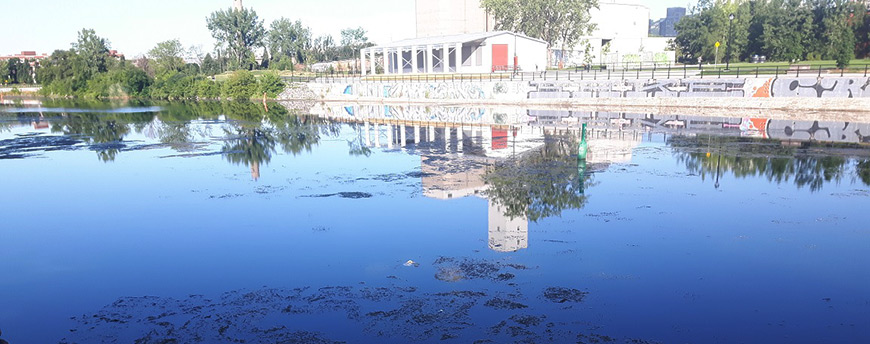
Wednesday, July 29, 2020
Watermilfoil and cyanobacteria
Algae and aquatic plants are frequently observed in Parks Canada’s historic canals in Quebec, including the Chambly and Lachine canals. Algae and aquatic plants are plants that naturally occur in all of the province’s water bodies and are a very important part of the aquatic ecosystem.
Eurasian watermilfoil
Eurasian watermilfoil is an invasive alien aquatic plant that can be found in the historic canals. Its stems are rooted in the sediment and can measure up to six metres long. Near the water’s surface, they branch out and can continue to grow horizontally and produce emergent flowering spikes. Eurasian watermilfoil then forms a dense canopy both on and below the water’s surface.
How to prevent the spread of watermilfoil?
Boaters navigating a water body contaminated by watermilfoil should avoid passing over stands of watermilfoil as much as possible and inspect and clean their boats to ensure that they do not spread the plant to another water body.
Is watermilfoil toxic and dangerous?
Watermilfoil is not toxic or dangerous to aquatic species or humans, but it could have adverse effects on biodiversity (loss of light, decreased oxygen levels in the water, etc.).


What about cyanobacteria?
Cyanobacteria (blue‑green algae) can sometimes be observed in the historic canals. They consist of aquatic micro‑organisms that are found in all water bodies in Quebec. Occasionally, excessive amounts are observed, which can pose a health risk, especially if contaminated water is ingested or contact is prolonged. It is important to note that not all cyanobacteria produce cyanotoxins.
- There is a risk to health, especially if contaminated water is ingested or in case of prolonged contact with the water.
- According to Health Canada, the main effects or symptoms are nausea, vomiting, abdominal pain and diarrhea if the water is swallowed and eye, skin and ear irritation when skin contact occurs.
- These symptoms are relatively mild and resolve quickly, with rare exceptions.
Due to the potential risks below, you may enjoy nautical and aquatic activities in areas of a body of water where you do not see blooms or scum. On the other hand, in areas where they are visible:
- stay at least 3 meters away from blooms or scum;
- avoid any activity that could bring you into contact with them.
You can resume nautical and aquatic activities in an area where the blooms or scum have disappeared, but only 24 hours after their disappearance. Avoid coming into direct contact with water during aquatic activities such as kayaking, canoeing or pedal boating. The risk is mainly present when there is an involuntary swim following a capsize.
Do not eat caught fish.
Make sure pets do not come into contact with water and do not drink the water.
Note that swimming is prohibited at all times in the historic canals.


Want to learn more? Visit the website of the Ministère de l’Environnement et de la Lutte contre les changements climatiques for more information.
Related links
- La Forêt Collective
- École en réseau - To learn connected to others
- A safe and pleasant winter trail
- 5 good reasons to come work for Parks Canada this summer!
- A Colourful Summer at Lachine Canal!
- Reopening of the Lachine Canal - 20 years already!
- Team Up and Clean Up
- 10 reasons to base your business at the Lachine Canal
- The History of a Little Coaster
- New electric vehicle
- Learn-to Paddle
- Newly Renovated Canals
- Public Art at the Hangar 1825
- Planting of trees
- Cyclo-pedestrian roundabout
- Inspirational women
- Date modified :